Genre: Beat-‘Em-Up Developer: Wolf Team Publisher: Telenet Players: 1 Released: 1993
I loved Wolfteam. It was one of the premier developers for the Genesis (under Renovation, the U.S. branch of Telenet Japan), and was responsible for many great titles. One such game was the side-scrolling action adventure El Viento, which means “the wind” in Spanish. It featured a green-haired heroine by the name of Anet Myer, who battled through 1920s New York to stop the revival of an evil god. A bit far-fetched to be sure, but overall it was a decent play.
Fast forward two years, and the sequel Anet Futatabi is released for the Mega CD in Japan. Anet, having been rescued from certain sacrifice by her now adopted father Ernest Evans (you’ll need to play his game for the low down, as all three titles are related), is traveling across Europe when she encounters a local sect that wants her special pendant. She’s ambushed in a castle and barely escapes, and so ensues the quest to stop yet another mystical plot to conquer the world.
Sounds decent enough, and if you’re a fan of the previous titles, you’re probably expecting more of the same side-scrolling action that defined them. Well, I hope you’re ready for a change, faithful reader. Perhaps the most jarring thing about Anet Futatabi is that the developers opted to forgo the standard platform dynamic of the other two games and instead made this one a beat-’em-up. Yep, a healthy dose of what the hell? is in order friends, as I still try to determine how this was supposed to help the game be better in some way.
Playing more like Streets of Rage than El Viento, Anet Futatabi comes off as the bastard child of two genres – a part of both, yet truly belonging to neither. Whereas previous outings concentrated more on action and pushing the Genesis (just check out the effects in Earnest Evans!), the Mega CD sequel hardly taxes either one of the two processors involved. Bland, first-generation graphics combine with tiny sprites to make you wonder where the heck all that CD storage space went. Ah, I know! Wolfteam shot its wad in the cut scenes, and used what was left for the rest of the game! Yeah, that sounds about right.
I’m not saying that everything’s bad, necessarily, just so uninspired and middle-of-the-road that you’re practically overwhelmed by the lost potential. The cinematic sequences are lovely (very lovely), but the lack of moves and repetitive enemies just suck the life out of any excitement you may have built up watching the story unfold. The gameplay simply doesn’t match the presentation.
Which is the true problem here. Where are the combos? Special moves? For a game released in 1993, it’s pretty sparse in the gameplay department. That, and the fact that the magic effects- if they can truly be called that- are borderline funny. C’mon Wolf Team! The original Golden Axe put more effort into its magic!
It’s a pity too, since I could almost see this actually working. Had Earnest been made a second player and the visuals been beefed up to at least Final Fight size and detail, this could have been something truly special. As it is, it’s merely a mediocre release that plays about as good as it looks.
To be fair, the game is pretty long, with a decent amount of stages to play through. There are also plenty of beautiful cut scenes to gander at between each one (have I mentioned those already?), and I’m sure that the plot is worthy of the other two installments that came before it. Both Anet and Earnest look great, and as one who has always preferred hand-drawn scenes to CG or FMV, I can point to Anet Futatabi as one of the best examples of how to use them. Awesome stuff, indeed.
Another big plus here is the wonderful red book soundtrack, which is solid the whole game through. It doesn’t surprise me in the slightest that this game should have such a great score, as most Sega CD titles of the time were little more than cartridge ports with redone music (Terminator, Wolf Child). Being red book means that you can play it in your stereo whenever you like, which is a neat feature that too many games today have lost.
So, what should you do? Invest in a copy of Anet Futatabi or avoid it entirely? I’d say go for it, as long as you don’t expect the second coming of beat-’em-ups. It’s not a bad game by any means, merely one that failed to live up to all the expectations the new Mega CD add-on brought with it. Had more time been given to development, it could really have been something that shone. Instead, the finished product comes off as rushed and lacking. But that’s the thing about looking back at past titles, hypotheticals have no weight.
SCORE: 6 out of 10

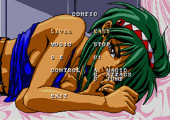
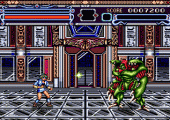
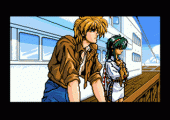
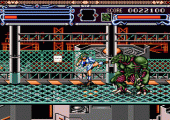
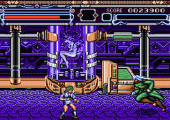
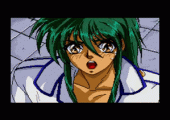
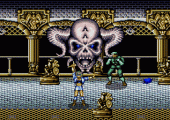
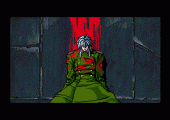
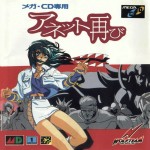
Pretty cutscenes and a red book soundtrack are fine, but the gameplay in Anet Futatabi is lousy, buggy, and way too easy. The magic system pretty much breaks the game, since enemies don’t pursue you and there’s no time limit, so you can just keep your distance and recharge until you can cast the dragon spell that kills everything on screen.
Otherwise some combination of throws and sliding kicks will dispatch almost everybody; only the spinning guys are tricky. Power-ups are everywhere so if you mess up, no biggie, there’s a Diet Coke cached in that ancient column. The boss fights are super-simplistic, and most can be killed easily just by dropping to a different horizontal plane and waiting for the right moment in their attack cycle.
Also, there’s some sprite priority issue going on, since parts of Anet kept disappearing, like something out of SMS Double Dragon. Tolerable in 1988, but not too impressive on the Mega CD.
This could have been a good game if there were more enemies and special moves, two-player simultaneous action, a time limit, and/or a magic system that makes sense. But as it stands, if you subtract the cutscenes and soundtrack, there’s practically nothing of value left.